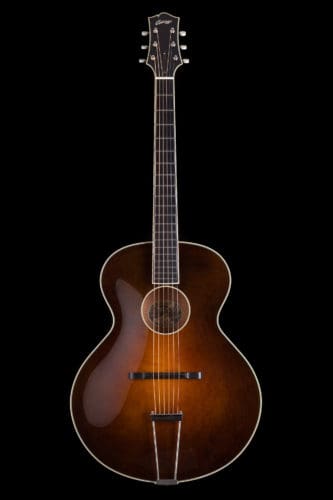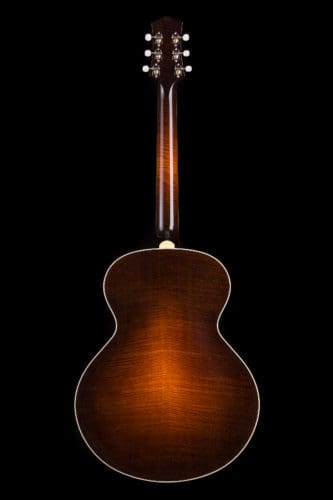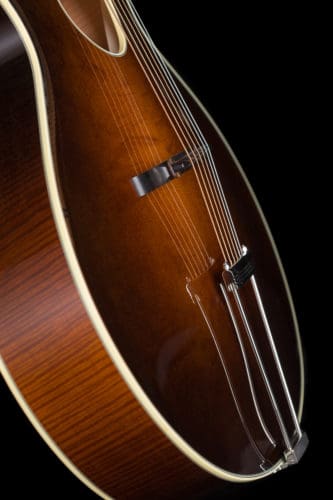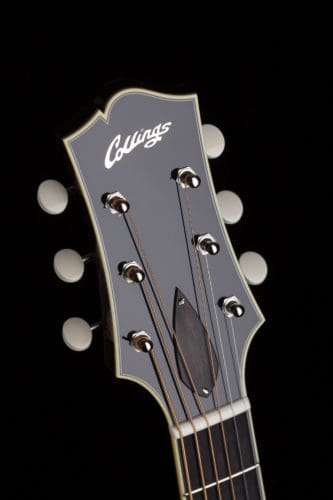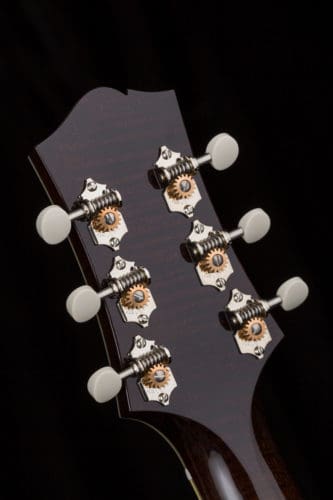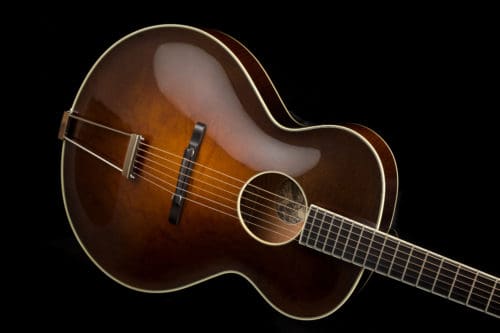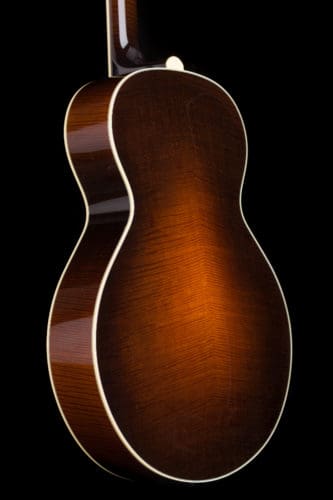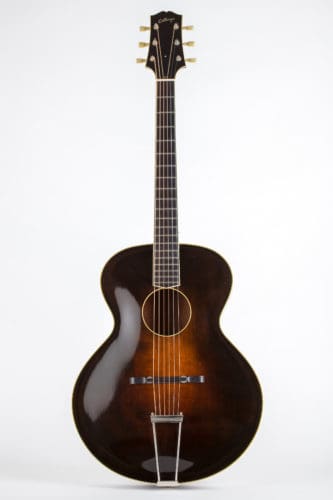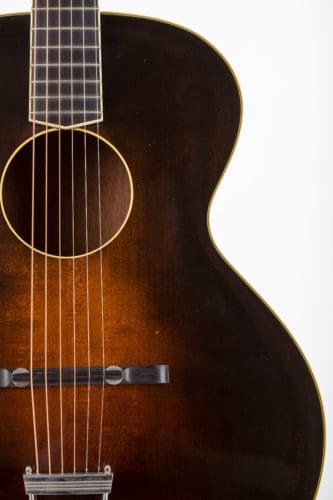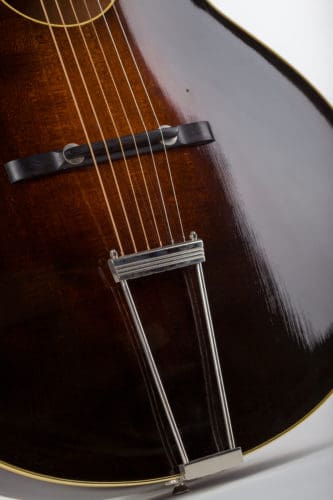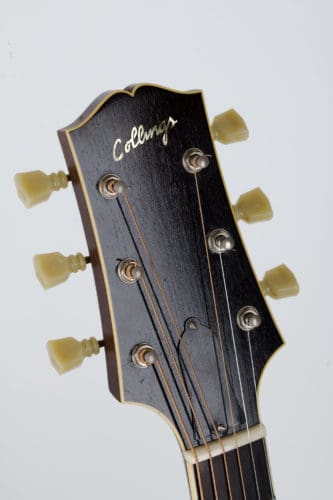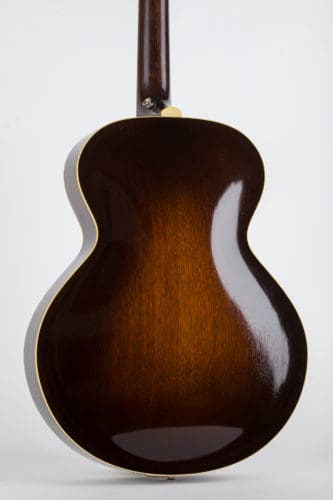It seems like you couldn’t know Bill Collings without having a favorite Bill Collings story. After Bill passed last summer we reached out to his friends and peers for their recollections and shared them in the Fretboard Journal 40. There were personal stories, the legendary pranks and the quirky little anecdotes. One of those quirky little anecdotes, Flip Scipio’s remembrance of Bill checking out a Jimmy D’Aquisto archtop at Mandolin Brothers, popped into my head just before NAMM earlier this year, when we heard that the folks at Collings were bringing a special tribute archtop to the show. At first, it might seem an odd choice–a Collings archtop is beautiful, but rare, not necessarily the first thing that comes to mind when most people think about a Collings instrument…
When we recently got a chance to talk to Aaron Huff, Bruce VanWart and Steve McCreary about that guitar–a round-holed 16″ archtop with flamed mahogany for the back and sides and a stunning sunburst on a bearclaw Red spruce top–the choice quickly made more sense.
“[We] didn’t wanna do a dreadnought, you know, or something like that,” Steve told us. “Archtops are pretty special instruments from Collings, and Bill used to do them himself. It’s something more special, something that was more Bill.”
Collings typically produces about three archtops a year, and the book has been closed for a while. They were built primarily by Bill (“He kind of kept these more to himself,” Steve notes) until about 13 years ago, when he began delegating more of the work to Aaron, who eventually took over as the primary builder on these instruments. As it happens, Steve has a round-holed 16″ archtop with mahogany back and sides that Bill built in 1983 (side note from Steve, “The logo on that is where he got the logo for the Julian [Lage Signature] guitar.”), and it was an inspiring choice for a starting point. Talking with them, it’s clear building this guitar is more than a tribute or a catharsis–it’s a statement, a commitment to Bill’s legacy.
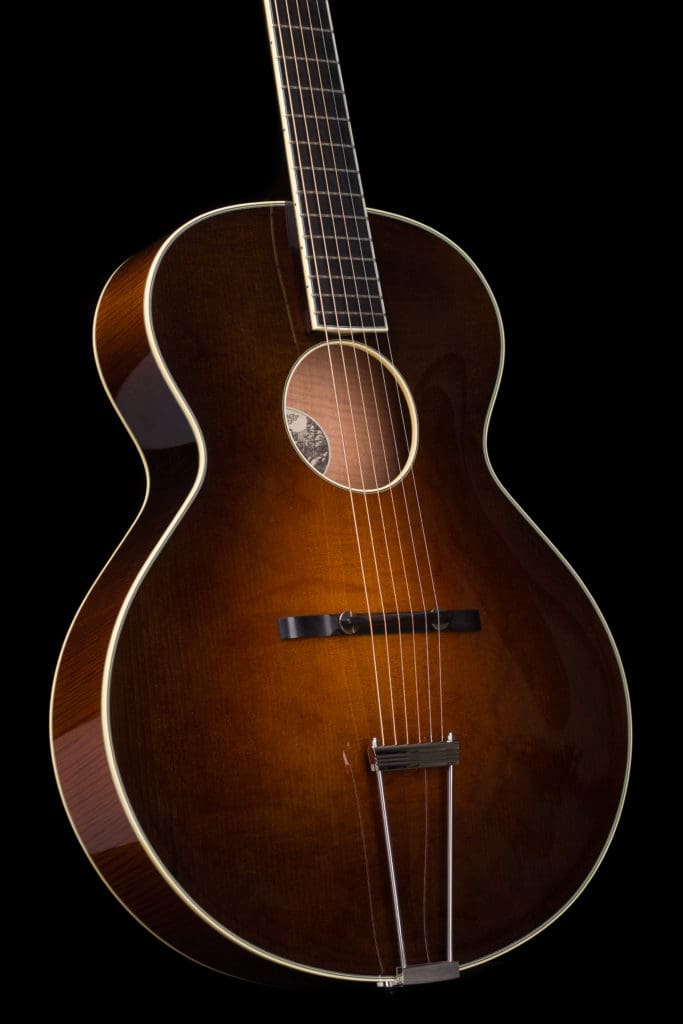
Aaron: It becomes kind of fun with a little bit of time and distance, because it gets to be a little bit about the guitar, and a little bit about Bill, and a little bit about us. I think that a little time is healthy for the perspective of it. But largely, that guitar was, as much a healing, you know, kind of just a moment for us to kind of gather together those of us that had spent a bunch of time with him, and with his work, and with our own work. Bill was an incredible mind, and incredible craftsman, and a fascinating human being, but there’s a lot more of those types of people around here, and I think it was necessary for us to honor him and also demonstrate that we were here to continue working this way.
So we just had fun with it. The guitar that Steve had bought was kind of like the coolest thing to bust out every now and then, to show a visitor or just for some of us to listen to. I think the most fun thing about working with Bill building those archtops is that he never really wanted to repeat himself, so he would alter a lot, whether it was like, changing the shape of the mold, or altering purflings or having a unique voicing, wood selection, you name it…
Bruce: The depth, sometimes, the radius recurved a little bit…
Aaron: So I know that if he had been there with us while we were thinking, or talking about it and thinking it through, he would’ve looked at Steve’s old guitar and said, “Yeah, I woulda changed this and changed this and changed this.” So the fun for me and Bruce was largely kind of interpreting what that would be, where it would go, and…
Bruce: What he would like.
Aaron: Yeah, and feeling, like, really confident on some things. That, “Oh, he would love this,” and then sitting there, asking each other questions about where it would go.
So, different from Steve’s guitar, we used a modern…well, I say modern…a current neck design, in terms of the the exterior shape, the peg head shape, the truss rod design, the way that the mortise and tenon is current and [how it] works, the purflings are different, the wood is much higher grade, the bracing was altered a little bit, we used the current logo… But at the same time, we did a lot of stuff that we knew he’d really enjoy, which is, you know, kind of an embellished purfling, and the rich color tones that he really enjoyed for years. I mean, every little part of that instrument, whether it was the wood selected for each piece, you just got used to working with him for a long time…It’s like, if you’re looking for brace wood, what, what is it that he wanted? And that’s Bruce’s M.O. now, with all the flat top wood selection and we’ve internalized it as our own, and sometimes our observations would be what went back and informed Bill to help make choices in the past.
And so we were able to cover a lot of ground in terms of remembering him and celebrating him, but at the same time, kind of, having fun moving forward [with] kind of a historical piece.
Steve: We haven’t built many round holes. He did a few oval holes in the ’80s, [but] I think, round holes, maybe only three…let’s see…Yeah, we did [one] in 1999, and I think there was one in 2005.
Aaron: Yeah. So there, that also made it just kind of a more unique piece.
Steve: And that was another reason to kinda go there with this guitar, because it was kind of something a little bit different, and, like I mentioned earlier, we didn’t wanna do, um, kind of a standard for this, you know? Even a standard archtop, much less a dreadnought or something like that.
Bruce is sitting here and hasn’t said much yet…
Aaron: I mean I tried covering it. Kinda got on there, but how, how do you feel how all the time that you had spent with Bill? You know, we had kinda thought it up and were working on it fairly recently after he passed away, and so I think one thing is, kind of like, he was sort of with us while we were doing that, in a weird way. What would he say about this? What would he think about that? I remember that being part of our conversation…
Bruce: Yeah, well, I know Bill would be pretty, “Just build it, have a ball.” That’s what he would say.
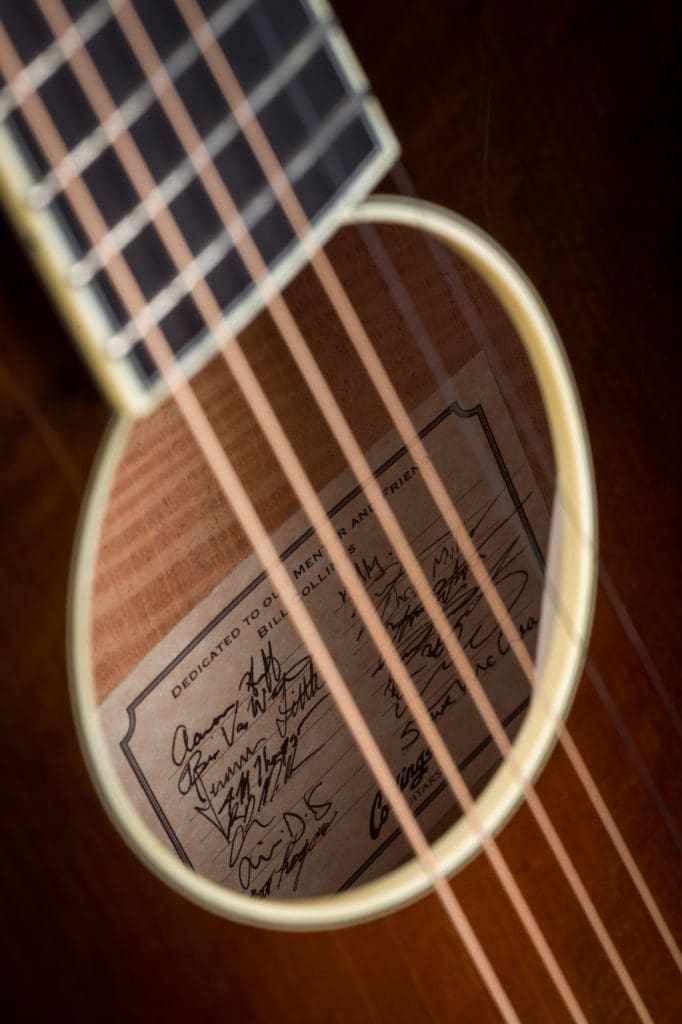
Aaron: True. And evaluate it later.
Bruce: And evaluate it later, yeah.
Fretboard Journal: So, looking at the guitar’s label, am I counting it right? 16 folks participated in this build?
Aaron: There’s, there should be, I remember, 16 signatures on there. So what that means is, the way that, that Bill wanted to structure this operation is you have these specialists in areas. Whether it’s machine operators or guys that spray lacquer, or folks that do the wet sanding and buffing… The arch tops were never really run down the line, of a production line, so to speak. They were…it was much more cautiously approached, just to maintain…just keeping his finger on it largely, a lot of the times to where he would get a handful of us to help, but never really just set it free down the same line that, say, a mandolin or acoustic guitar or electric guitar would follow.
But we all felt like at that stage that it was really important for anybody that was able to participate to participate, and so whether it was the folks that did the buffing or Steve that went and brought the inspiration for the guitar and helped us kind of think it through, or whether it was, um, the folks that operated the machine that helps us make some of the parts…
Steve: The guy spraying the guitar and like [Aaron] said, kind of every, everyone that had a hand in any facet of this, because those people have a hand in everything we do.
Aaron: And they also had a real relationship with Bill. We all wanted to have this effort kind of pull those people together and make us look at each other and ourselves and the work and say, “This is what we do, and yeah, we’re doing it because of him, but it’s us doing it, and there’s purpose in that. There’s value in that. There’s intent in that and there’s a future in that.” I think that it’s critical that we kinda have that mantra among us as we continue to work on his art. That’s the way I really see it: it was his art. The archtops really were like that extension of a production setting that moved into art. If you look at a collection of his archtops anywhere, they have a consistency in execution that I think rivals anything in the world.
Steve: He kinda did these on his own way beyond when the shop was doing stuff in a real production kind of environment. We don’t build a whole lot of stuff, but we build high end stuff, and it is in a production style, but he kind of kept these more to himself, and then he brought in Aaron the last, what, ten years? And [Aaron]’s built predominantly built the archtops for about ten years or so.
Aaron: It was actually 2005… It was, like, the fall of 2005, he had multiple of those guitars going. He had like three or four of them up there in the mando shop. Do you remember that?
Steve: Yeah. He had a million parts everywhere…
Aaron: He had, he was just like, “I need somebody else just to, like, make these motions…” and kinda got us going. I remember if he was in a tight spot he would run right at Bruce and say, “I need you to do this…” – get it bound right or get it sanded out flatter. But we were able to involve a slightly broader loop for his project, and I think that was a total net win. I really think that how unique that guitar is, and how beautiful it is really goes to show the value of his approach in building it, because Bill, as much as he enjoyed working on those things and kind of wanting to keep them as his art and very, very carefully crafted, he also was very keen on educating and empowering and delegating and all those things that, that brought us all to today, with what we’re doing.
Steve: And this being a more exclusive model – you know, we only built three a year or so – the team that this got delegated to was a certainly a smaller team, to keep it an exclusive thing, keep it to the the level that he wanted it done at. We stopped taking orders from these for the last several years, and we have quite a few on order, and we can only build a few because it takes extra time, outside of our production, so it’s something very special we wanted to do and it worked out really well with Aaron and Bruce leading this crew to do this.
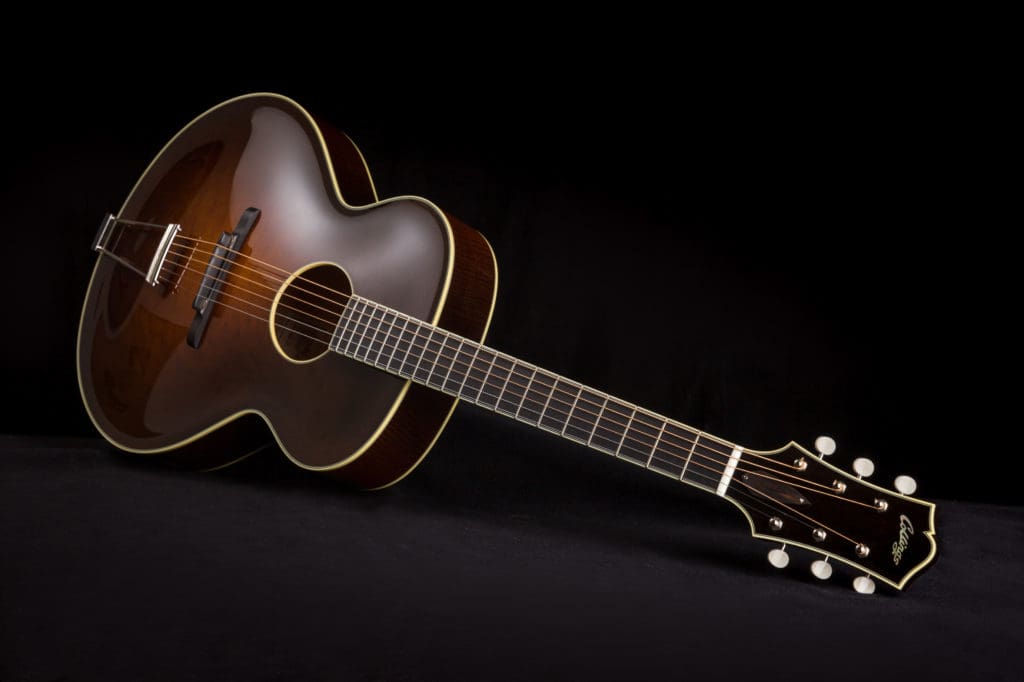
FJ: Are you gonna open up that book again soon?
Steve: No. Some people read that, when we put it out, as kind of a product launch, [laughs] and it’s really not. It’s really just kind of a one-off.
Aaron: The shape of things to come has more to do with the philosophy, and the intent, of…
Steve: Of carrying on Bill’s work, not really that guitar, because it’s a very special guitar.
Aaron: I think Bruce and I wanna be doing a few more round holes.
Bruce: We might revisit it.
Aaron: Yeah, we’re not done. You know? As luthiers and students of lutherie, I think it takes multiples to get it, to be able to negotiate the variables in a very informed way and I think that guitar was just enough of a departure for us to say, there’s constantly something to learn. When we had sat down with Bill before he passed and really wanted to be on the same page as him about, do we continue this artwork or not? Or do we work in the production style? He was, he was super enthusiastic and encouraging about doing this work, and his blessing was very clear in saying how much he wanted us to continue with that style of build. So I think that we have no choice but to continue.
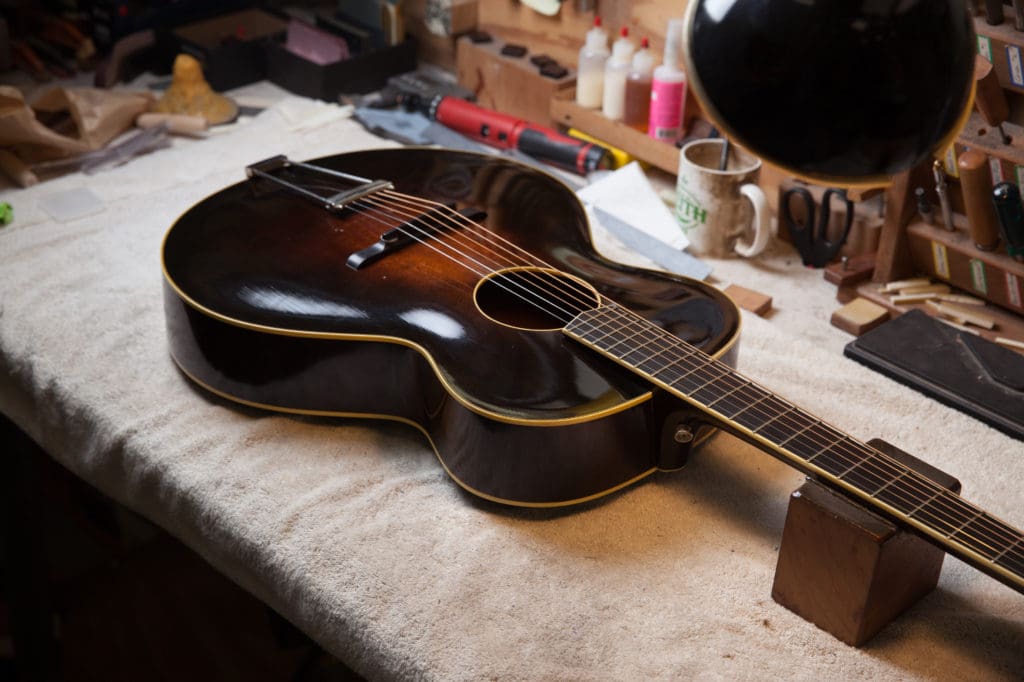
FJ: How does this guitar compare to Steve’s?
Aaron: Steve’s is really interesting because it is so much older. That was one of the things, from a luthier’s perspective: how we really thought about how Bill would’ve let it evolve. Steve’s guitar, some of the geometry and the plate graduations…it has a really nice, dry looseness to it that is very endearing and very inviting to play, and we liked that, but we’re also looking at how time and physics and everything had acted on it and sort of thinking about how Bill would’ve approached those observations 35 years later. And so Bruce and I talked a lot about that and in terms of the way it’s reinforced and neck angle and all these plate graduation and brace carving and all these little things and wound up with a guitar that’s a little bit more focused, a little faster and a slightly brighter kind of harmonic content.
Bruce: Yeah, that’s about right. It’s always nice to be able to take an older instrument and go, “Well, you know, I think that we could change it hear a little bit and change it there a little bit and improve it,” because you have something that’s already been tried. You know? It’s really great overall just visiting old instruments, but it’s great that we had this other instrument to go from.
Aaron: It’s certainly it’s a little bit, quite a bit different guitar. I mean if we remember, the old one was a slab sawn kind of real thin mahogany back…
Bruce: And,we could’ve done that, but we just wanted it to be something that was…
Aaron: The next step.
Bruce: Yeah, the next step. Evolutionary.
FJ: That top is kind of an incredible piece of wood, just looking at it. Can you tell us a little bit about it?
Bruce: We had that wood floating around for a long time, and it just kind of decided that would be a good route because it was really well seasoned and it was the weight we were looking for and a nice look as far as grain widths and stuff, and just having the extra splash of the bear claw in there would also give it possibly a little bit more of contemporary feel.
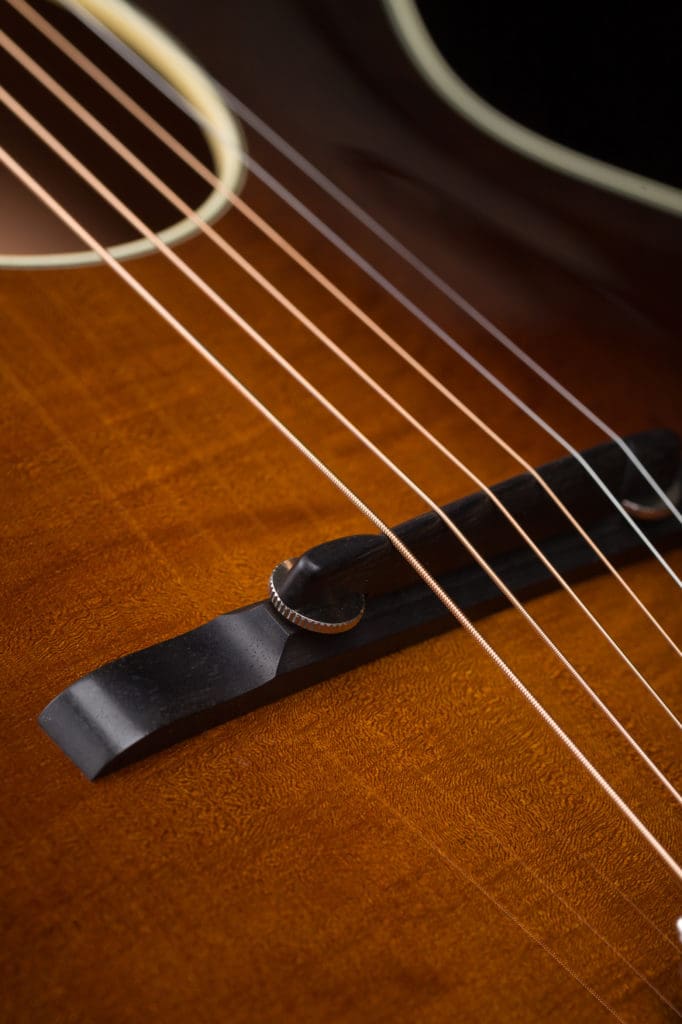
Aaron: I think the really important thing about that piece of wood is that we pulled out all options, didn’t we? Because Bill’s old guitar was made from some old like kind of real consistent grain sitka, and it sounded like it. I think when you’re working and you’re in the territory where you’re really trying to say something, then we’re gonna, you know, get our hands on the best meat we could. That’s what Bill always used to say, “Get good meat.” You know, he’s looking at that, at the grain structure between the winter rings, and he’s sitting there saying, “I love the meat on this”. That was always what he used to say. And it didn’t honestly matter what species it was. He was after, you know, everything from chatoyance to quartering…
Adirondack was always kind of like the side option, for people that really wanted that powerful thing that was gonna continue to evolve and get bigger and louder and, and more powerful. Adirondack was, was a minority of the guitars that we made, but that’s why it kind of felt special to do it, because we knew it would have the strength and the mass that would help the sound, and then the visual aesthetic was just a helping hand in making the decision.
FJ: What kind of players end up with these archtops? Are they more modern players? Swing rhythm players or fingerstyle guys, or…
Aaron: Kind of all of the above. We’ve seen traditional jazz players, but then you also see the swing players. Bill I think really liked some of that stuff because he got to build the guitar heavy. He got to enjoy putting a lot in there, and not making it necessarily super-light and super-dainty, because he really enjoyed making, you know, a big block V-8 out of an archtop.
Photos courtesy of Collings Guitars.
